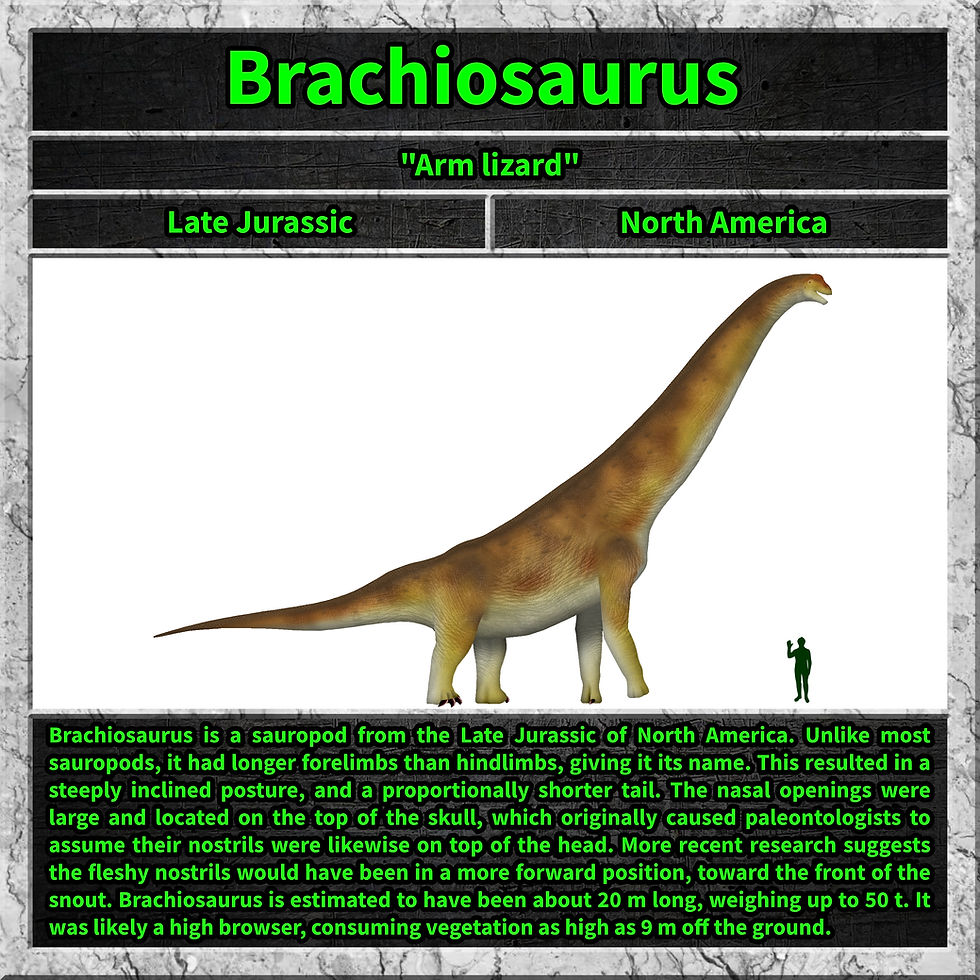Brachiosaurus
- unexpecteddinolesson
- Apr 21, 2024
- 2 min read
MEANING: Arm lizard
PERIOD: Late Jurassic
CONTINENT: North America
Brachiosaurus is a sauropod from the Late Jurassic of North America. Unlike most sauropods, it had longer forelimbs than hindlimbs, giving it its name. This resulted in a steeply inclined posture, and a proportionally shorter tail. The nasal openings were large and located on the top of the skull, which originally caused paleontologists to assume their nostrils were likewise on top of the head. More recent research suggests the flesfhy nostrils would have been in a more forward position, toward the front of the snout. Brachiosaurus is estimated to have been about 20 m long, weighing up to 50 t. It was likely a high browser, consuming vegetation as high as 9 m off the ground.

Brachiosaurus is from the Jurassic. The Jurassic is a geologic period that spanned from the end of the Triassic, 201 million y ears ago, to the beginning of the Cretaceous, 145 million years ago. It is the middle period of the Mesozoic Era. The start of the Jurassic was marked by the major Triassic-Jurassic extinction event. The end, however, has no clear boundary with the Cretaceous. By the beginning of the Jurassic, Pangea had begun rifting into two landmasses: Laurasia and Gondwana, and the climate was warm with no ice caps. Life on land was dominated by dinosaurs, and the first birds appeared, evolving from a branch of theropods. The oceans were inhabited by marine reptiles, while pterosaurs were the dominant flying vertebrates.
Brachiosaurus is a sauropod. Sauropods are saurischian dinosaurs that had very long necks, long tails, small heads (relative to the rest of their body), and four thick, pillar-like legs. They are notable for the enormous sizes attained by some species, and the group includes the largest animals to have ever lived on land. Well-known genera include Brachiosaurus, Diplodocus, Apatosaurus and Brontosaurus.
The oldest known unequivocal sauropod dinosaurs are known from the Early Jurassic, and by the Late Jurassic (150 million years ago), sauropods had become widespread. By the Late Cretaceous, one group of sauropods, the titanosaurs, had replaced all others and had a near-global distribution. This group included the largest animals ever to walk the earth. Estimates vary, but the largest titanosaurs are estimated at upward of around 40 m, and weighing 100 t, or possibly even more.
As with all other non-avian dinosaurs alive at the time, the titanosaurs died out in the Cretaceous–Paleogene extinction event. Fossilized remains of sauropods have been found on every continent, including Antarctica.




